day12-实现Spring底层机制-02
实现Spring底层机制-02
3.实现任务阶段1
3.1知识拓展-类加载器
- Java的类加载器有三种:
- Bootstrap类加载器 ----- 对应路径 jre/lib
- Ext类加载器 ----- 对应路径 jre/lib/ext
- App类加载器 ----- 对应路径 classpath
- classpath 类路径,就是java.exe执行时,指定的路径。
3.2分析
阶段1目标:编写自己的spring容器,实现扫描包,得到bean的class对象
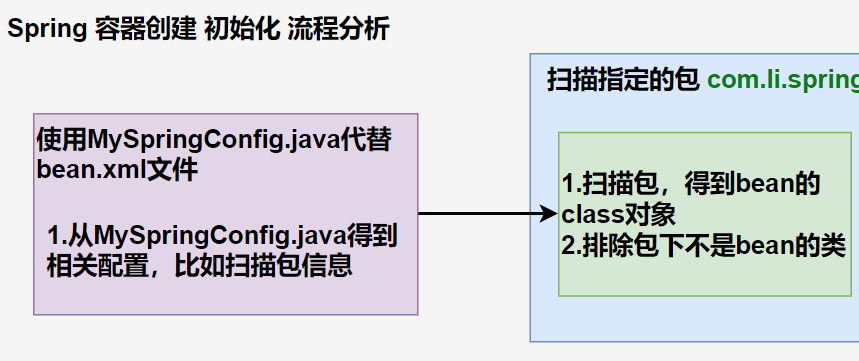
3.3代码实现
1.创建新的maven项目,注意把项目的 language level 改为支持 java8
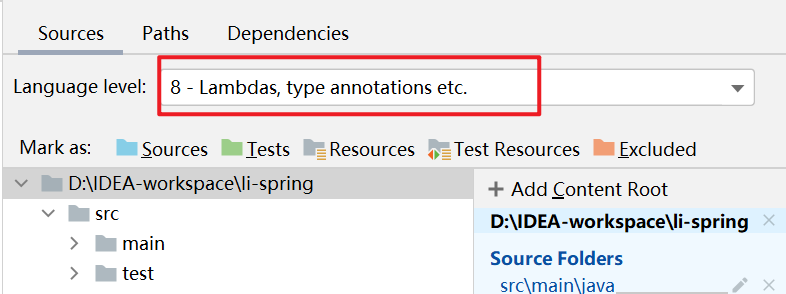
在pom.xml文件中指定编译版本:
<properties>
<maven.compiler.source>8</maven.compiler.source>
<maven.compiler.target>8</maven.compiler.target>
</properties>
2.创建的架构如下:

3.自定义ComponentScan注解,用于标记要扫描的包
package com.li.spring.annotation;
import java.lang.annotation.ElementType;
import java.lang.annotation.Retention;
import java.lang.annotation.RetentionPolicy;
import java.lang.annotation.Target;
/**
* @author 李
* @version 1.0
* 模仿spring原生注解,自定义一个注解
* 1. @Target(ElementType.TYPE) 指定ComponentScan注解可以修饰TYPE元素
* 2. @Retention(RetentionPolicy.RUNTIME) 指定ComponentScan注解 的保留范围
* 3. String value() default ""; 表示 ComponentScan 可以传入一个value值
*/
@Target(ElementType.TYPE)
@Retention(RetentionPolicy.RUNTIME)
public @interface ComponentScan {
//通过value指定要扫描的包
String value() default "";
}
4.自定义Component注解,用于标记要扫描的类
package com.li.spring.annotation;
import java.lang.annotation.ElementType;
import java.lang.annotation.Retention;
import java.lang.annotation.RetentionPolicy;
import java.lang.annotation.Target;
@Target(ElementType.TYPE)
@Retention(RetentionPolicy.RUNTIME)
public @interface Component {
//通过value给要注入的bean指定名字
String value() default "";
}
5.自定义配置类,相当于原生spring的容器配置文件
package com.li.spring.ioc;
import com.li.spring.annotation.ComponentScan;
/**
* @author 李
* @version 1.0
* 这是一个配置类,作用类似我们原生 spring 的容器配置文件 beans.xml
*/
@ComponentScan(value = "com.li.spring.component")
public class MySpringConfig {
}
6.自定义spring容器,类似原生ioc容器。(未完成)
目前的功能:
(1)在初始化时,根据传入的配置类.class文件,读取要扫描的包路径
(2)遍历包路径下的文件,找出需要注入的bean
package com.li.spring.ioc;
import com.li.spring.annotation.Component;
import com.li.spring.annotation.ComponentScan;
import java.io.File;
import java.net.URL;
/**
* @author 李
* @version 1.0
* MySpringApplicationContext 类的作用类似Spring原生的ioc容器
*/
public class MySpringApplicationContext {
private Class configClass;
//构造器
public MySpringApplicationContext(Class configClass) {
this.configClass = configClass;
//步骤一:获取要扫描的包
//1.先得到 MySpringConfig配置类的注解 @ComponentScan(value = "com.li.spring.component")
ComponentScan componentScan =
(ComponentScan) this.configClass.getDeclaredAnnotation(ComponentScan.class);
//2.通过 componentScan的 value=>得到要扫描的包路径
String path = componentScan.value();
System.out.println("要扫描的包=" + path);
//步骤二:得到要扫描的包下的所有资源(类.class)
//1.得到类的加载器-->App 类加载器
ClassLoader classLoader = MySpringApplicationContext.class.getClassLoader();
//2.通过类的加载器获取到要扫描的包的资源 url=>类似一个路径
path = path.replace(".", "/");//将原先路径的.替换成/ ==> com/li/component
URL resource = classLoader.getResource(path);
//resource=file:/D:/IDEA-workspace/spring/out/production/spring/com/li/component
System.out.println("resource=" + resource);
//3.将要加载的资源(.class)路径下的文件进行遍历
File file = new File(resource.getFile());
if (file.isDirectory()) {
File[] files = file.listFiles();//将当前目录下的所有文件放到files数组中(这里没有实现递归)
for (File f : files) {
//System.out.println("============");
//System.out.println("AbsolutePath=" + f.getAbsolutePath());
//获取文件的绝对路径
String fileAbsolutePath = f.getAbsolutePath();
//只处理.class文件
if (fileAbsolutePath.endsWith(".class")) {
//步骤三:获取全类名反射对象,并放入容器中
//将其转变为 com.li.spring.component.MyComponent.class 形式
//1.先获取到类名
String className = fileAbsolutePath.substring(
fileAbsolutePath.lastIndexOf("\\") + 1,
fileAbsolutePath.indexOf(".class"));
//2.获取类的完整路径(全类名)
// path.replace("/", ".") => com.li.component
String classFullName = path.replace("/", ".") + "." + className;
//3.判断该class文件是否要注入到容器中(该类是否有特定注解)
try {
/*
得到该类的Class对象:
(1)Class.forName(className) 可以反射加载类
(2)classLoader.loadClass(className)也可以反射类的Class
主要区别是:(1)的方式会调用该类的静态方法,(2)的方法不会
*/
//因为这里只是要判断该类有没有注解,因此使用比较轻量级的方式
Class<?> clazz = classLoader.loadClass(classFullName);
//判断该类是否有特定注解
if (clazz.isAnnotationPresent(Component.class)) {
//以 Component注解为例,如果有其他注解,逻辑一致
//如果该类使用了 @Component ,说明是spring bean
System.out.println("是一个spring bean=" + clazz + " 类名=" + className);
} else {
//如果没有使用,则说明不是spring bean
System.out.println("不是一个 spring bean=" + clazz + " 类名=" + className);
}
} catch (Exception e) {
e.printStackTrace();
}
}
}
System.out.println("===========================");
}
}
//编写方法,返回容器对象
public Object getBean(String name) {
return null;
}
}
7.创建两个自定义 Spring bean,一个普通类作为测试
(1)MonsterService
package com.li.spring.component;
import com.li.spring.annotation.Component;
/**
* @author 李
* @version 1.0
* MonsterService 是一个 Service
* 1.如果指定了value,那么在注入spring容器时,以你指定的为准
* 2.如果没有指定value,则使用类名(首字母小写)作为默认名
*/
@Component(value = "monsterService") //将 MonsterService注入到自己的spring容器中
public class MonsterService {
}
(2)MonsterDao
package com.li.spring.component;
import com.li.spring.annotation.Component;
/**
* @author 李
* @version 1.0
*/
@Component(value = "monsterDao")
public class MonsterDao {
}
(3)Car,普通类
package com.li.spring.component;
/**
* @author 李
* @version 1.0
*/
public class Car {
}
8.进行测试
package com.li.spring.test;
import com.li.spring.ioc.MySpringApplicationContext;
import com.li.spring.ioc.MySpringConfig;
/**
* @author 李
* @version 1.0
*/
public class AppMain {
public static void main(String[] args) {
MySpringApplicationContext ioc =
new MySpringApplicationContext(MySpringConfig.class);
}
}
测试结果:成功区分指定包下的 bean 和普通类
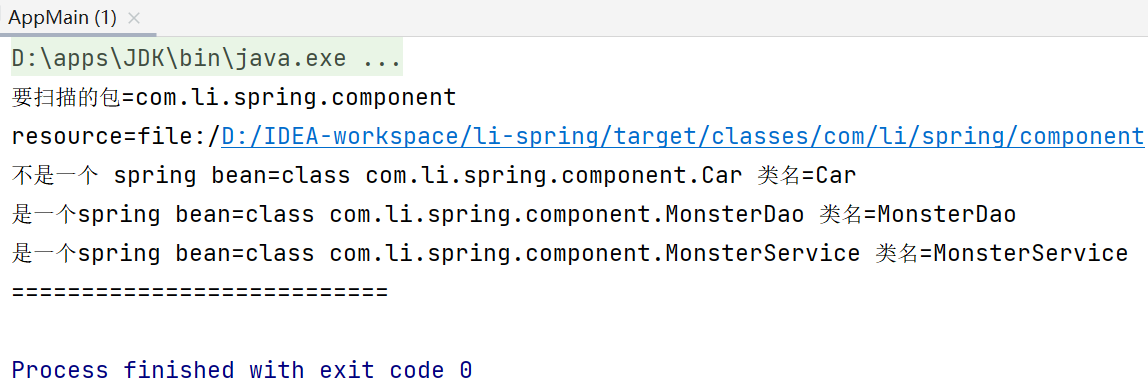
4.实现任务阶段2
4.1分析
阶段2目标:扫描指定包,将bean信息封装到BeanDefinition对象,并放入到Map
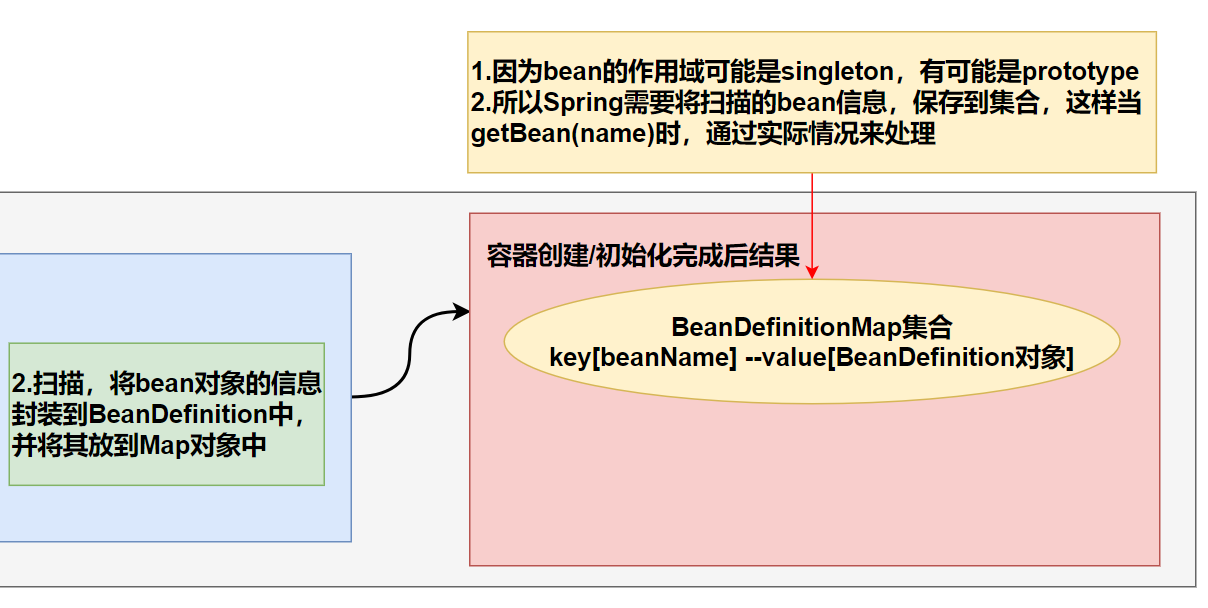
BeanDefinitionMap以k-v形式存放bean对象的信息。
- key为bean对象的id
- value为BeanDefinition对象,该对象存放bean信息。如果bean为prototype,应保存bean的class对象,这样在调用getBean()方法时可以动态创建对象。
新添加的注解和类:
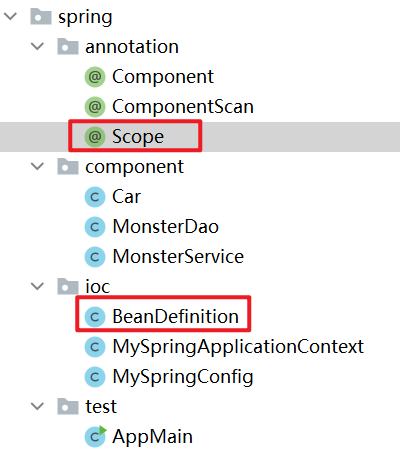
4.2代码实现
1.自定义注解,用于指定 bean 是单例还是多例
package com.li.spring.annotation;
import java.lang.annotation.ElementType;
import java.lang.annotation.Retention;
import java.lang.annotation.RetentionPolicy;
import java.lang.annotation.Target;
/**
* @author 李
* @version 1.0
* Scope 用于指定 bean的作用范围 [singleton/prototype]
*/
@Target(ElementType.TYPE)
@Retention(RetentionPolicy.RUNTIME)
public @interface Scope {
//通过 value 指定 bean 是 singleton 或 prototype
String value() default "";
}
2.修改MonsterService,添加Scope注解

3.BeanDefinition 用于封装/记录 Bean对象的信息
package com.li.spring.ioc;
/**
* @author 李
* @version 1.0
* 用于封装/记录 Bean对象的信息:
* 1.scope
* 2.Bean对应的 Class对象,用于反射生成对应对象
*/
public class BeanDefinition {
private String scope;
private Class clazz;
public String getScope() {
return scope;
}
public void setScope(String scope) {
this.scope = scope;
}
public Class getClazz() {
return clazz;
}
public void setClazz(Class clazz) {
this.clazz = clazz;
}
@Override
public String toString() {
return "BeanDefinition{" +
"scope='" + scope + '\'' +
", clazz=" + clazz +
'}';
}
}
4.修改自定义spring容器 MySpringApplicationContext
增加的功能:
(1)定义属性beanDefinitionMap,用于存放BeanDefinition对象,BeanDefinition对象存储bean信息,包括bean是单例还是多例,bean的class对象
(2)将MySpringApplicationContext构造器的所有代码封装成一个方法。
部分代码:
package com.li.spring.ioc;
//...
/**
* @author 李
* @version 1.0
* MySpringApplicationContext 类的作用类似Spring原生的ioc容器
*/
public class MySpringApplicationContext {
private Class configClass;
//定义属性 BeanDefinitionMap->存放BeanDefinition对象
private ConcurrentHashMap<String, BeanDefinition> beanDefinitionMap = new ConcurrentHashMap<>();
//构造器
public MySpringApplicationContext(Class configClass) {
beanDefinitionByScan(configClass);
System.out.println("beanDefinitionMap=" + beanDefinitionMap);
}
//该方法完成对指定包的扫描,并将Bean信息封装到BeanDefinition对象,再放入map中
public void beanDefinitionByScan(Class configClass) {
//步骤一:获取要扫描的包
//...
//步骤二:得到要扫描的包下的所有资源(类.class)
//...
//步骤三:获取全类名反射对象,并放入容器中
//...
//判断该类是否有特定注解
if (clazz.isAnnotationPresent(Component.class)) {
//如果该类使用了 @Component ,说明是spring bean
System.out.println("是一个spring bean=" + clazz + " 类名=" + className);
//-------------------新增代码----------------------
//得到 BeanName-key
//1.得到 Component 注解
Component componentAnnotation = clazz.getDeclaredAnnotation(Component.class);
//2.得到Component注解的value值
String beanName = componentAnnotation.value();
//如果没有指定,就使用类名(首字母小写)作为beanName
if ("".equals(beanName)) {
beanName = StringUtils.uncapitalize(className);
}
//将 Bean信息封装到 BeanDefinition对象-value
BeanDefinition beanDefinition = new BeanDefinition();
beanDefinition.setClazz(clazz);
//1.获取scope
if (clazz.isAnnotationPresent(Scope.class)) {
//如果配置了Scope,就设置配置的值
Scope scopeAnnotation = clazz.getDeclaredAnnotation(Scope.class);
beanDefinition.setScope(scopeAnnotation.value());
} else {
//如果没有配置Scope,就设置默认值singleton
beanDefinition.setScope("singleton");
}
//将beanDefinition对象放入Map中
beanDefinitionMap.put(beanName, beanDefinition);
//--------------------新增代码------------------------
} else {
//如果没有使用,则说明不是spring bean
System.out.println("不是一个 spring bean=" + clazz + " 类名=" + className);
}
} catch (Exception e) {
e.printStackTrace();
}
}
System.out.println("===========================");
}}}
//编写方法,返回容器对象
public Object getBean(String name) {
return null;
}
}
ps:这里使用了一个工具包
<dependencies>
<dependency>
<groupId>commons-lang</groupId>
<artifactId>commons-lang</artifactId>
<version>2.6</version>
</dependency>
</dependencies>
5.为了测试,将MonsterService的@Component的value注释

6.测试类
//...
public class AppMain {
public static void main(String[] args) {
MySpringApplicationContext ioc =
new MySpringApplicationContext(MySpringConfig.class);
}
}
测试结果:成功扫描指定包,并将bean对象的信息放入到beanDefinitionMap中,没有指定beanId的对象以默认规则作为id。
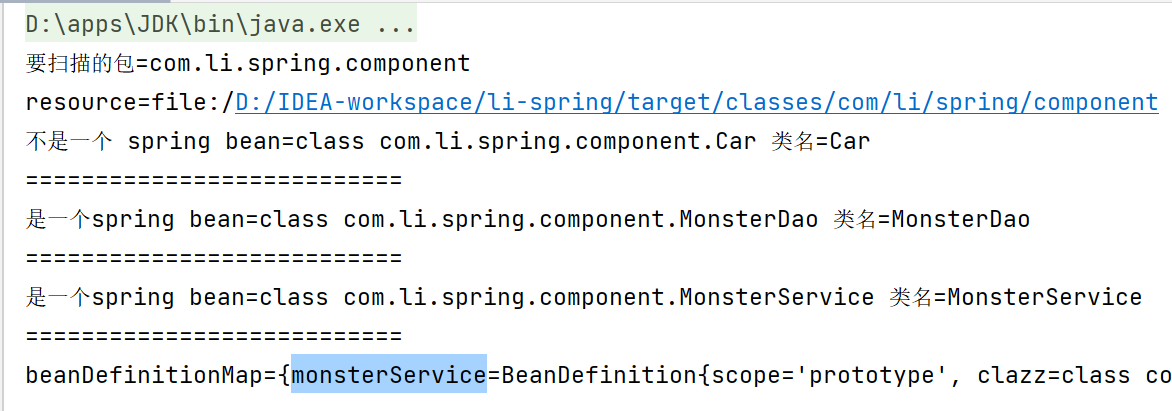
5.实现任务阶段3
5.1分析
阶段3目标:初始化bean单例池,并完成getBean方法,createBean方法
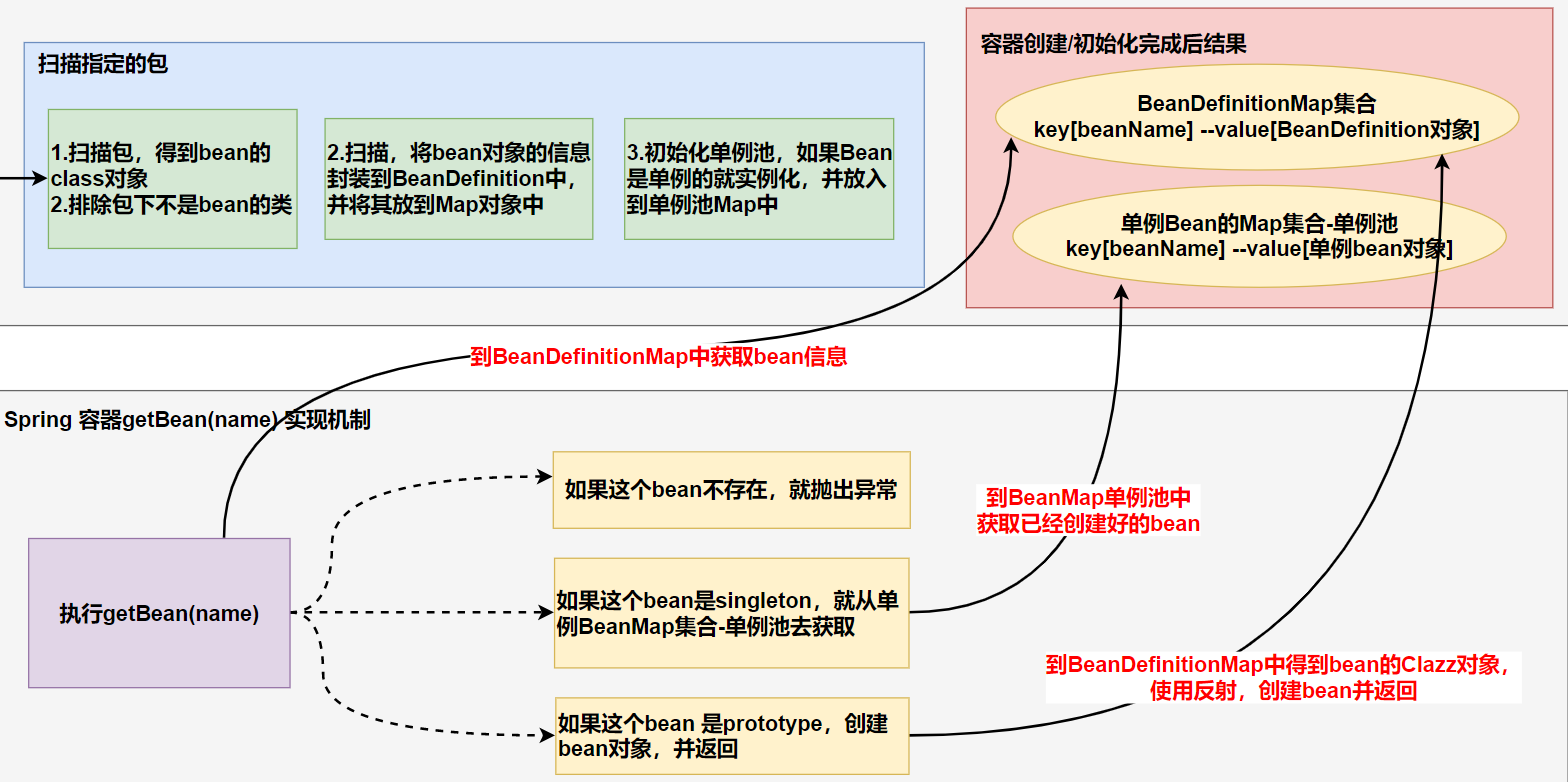
5.2代码实现
1.修改自定义spring容器 MySpringApplicationContext
增加的功能:
(1)增加方法createBean(),用于通过反射创建bean对象
(2)在构造方法中,初始化单例池:如果bean是单例,就通过createBean()将其实例化,然后放入单例池。
(3)实现getBean方法:通过beanName,返回bean对象。
部分代码:
//构造器
public MySpringApplicationContext(Class configClass) {
beanDefinitionByScan(configClass);
//后期封装成方法---------
Enumeration<String> keys = beanDefinitionMap.keys();
//遍历
while (keys.hasMoreElements()) {
//得到 beanName
String beanName = keys.nextElement();
//通过beanName得到对应的 beanDefinition 对象
BeanDefinition beanDefinition = beanDefinitionMap.get(beanName);
//判断该 bean 是单例还是多例
if ("singleton".equals(beanDefinition.getScope())) {
//将该bean实例放入到singletonObjects中
singletonObjects.put(beanName, createBean(beanDefinition));
}
}
System.out.println("singletonObjects 单例池=" + singletonObjects);
//------------
System.out.println("beanDefinitionMap=" + beanDefinitionMap);
}
//完成createBean(BeanDefinition)方法
public Object createBean(BeanDefinition beanDefinition) {
//得到Bean的class对象
Class clazz = beanDefinition.getClazz();
try {
//反射创建bean实例
Object instance = clazz.getDeclaredConstructor().newInstance();
return instance;
} catch (InstantiationException e) {
e.printStackTrace();
} catch (IllegalAccessException e) {
e.printStackTrace();
} catch (InvocationTargetException e) {
e.printStackTrace();
} catch (NoSuchMethodException e) {
e.printStackTrace();
}
//如果反射对象失败
return null;
}
//编写方法,返回容器对象
public Object getBean(String name) {
//传入的beanName是否在 beanDefinitionMap中存在
if (beanDefinitionMap.containsKey(name)) {//存在
//从 beanDefinitionMap中获取 beanDefinition对象
BeanDefinition beanDefinition = beanDefinitionMap.get(name);
if ("singleton".equalsIgnoreCase(beanDefinition.getScope())) {
//如果是单例 bean,直接从单例池获取
return singletonObjects.get(name);
} else {//如果不是单例,调用createBean(),反射创建对象
return createBean(beanDefinition);
}
} else {//不存在
//抛出空指针异常
throw new NullPointerException("不存在该bean=" + name);
}
}
2.测试类
//...
public class AppMain {
public static void main(String[] args) {
MySpringApplicationContext ioc =
new MySpringApplicationContext(MySpringConfig.class);
//Object xxx = ioc.getBean("xxx");//抛出空指针异常
//多实例对象的获取
MonsterService monsterService = (MonsterService) ioc.getBean("monsterService");
MonsterService monsterService2 = (MonsterService) ioc.getBean("monsterService");
System.out.println("monsterService=" + monsterService);
System.out.println("monsterService2=" + monsterService2);
//单实例对象的获取
MonsterDao monsterDao = (MonsterDao) ioc.getBean("monsterDao");
MonsterDao monsterDao2 = (MonsterDao) ioc.getBean("monsterDao");
System.out.println("monsterDao=" + monsterDao);
System.out.println("monsterDao2=" + monsterDao);
}
}
测试结果:在创建MySpringApplicationContext对象时,成功初始化了单例池,beanDefinitionMap。并根据beanName返回bean对象。MonsterService添加了Scope=“prototype”注解,因此每一次获取的对象都是不同的。

6.实现任务4
6.1分析
阶段4目标:完成依赖注入
6.2代码实现
1.自定义注解AutoWired,用于标记需要依赖注入的属性
package com.li.spring.annotation;
import java.lang.annotation.ElementType;
import java.lang.annotation.Retention;
import java.lang.annotation.RetentionPolicy;
import java.lang.annotation.Target;
/**
* @author 李
* @version 1.0
*/
@Target({ElementType.METHOD, ElementType.FIELD})
@Retention(RetentionPolicy.RUNTIME)
public @interface AutoWired {
//如果为true,就完成依赖注入
boolean required() default true;
}
2.为了测试,在MonsterDao,MonsterService中添加测试代码。
(1)修改MonsterDao,在该类中增加方法

(2)修改MonsterService,在该类中添加属性monsterDao,并使用AutoWired注解修饰。在方法m1()中调用属性对象的方法。
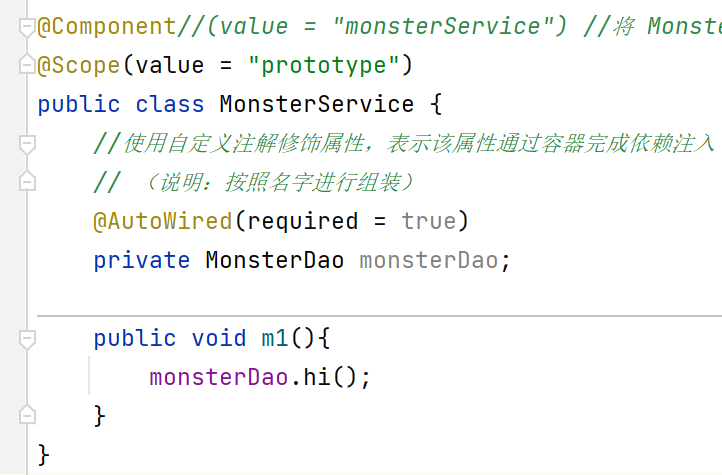
3.修改自定义spring容器 MySpringApplicationContext (部分代码)
修改方法createBean(),因为依赖注入需要在反射创建bean对象时完成。
//完成createBean(BeanDefinition)方法
public Object createBean(BeanDefinition beanDefinition) {
//得到Bean的class对象
Class clazz = beanDefinition.getClazz();
try {
//反射创建bean实例
Object instance = clazz.getDeclaredConstructor().newInstance();
//todo 这里要加入依赖注入的业务逻辑
//1.遍历当前要创建对象的所有属性字段
for (Field declaredField : clazz.getDeclaredFields()) {
//2.判断字段是否有AutoWired注解
if (declaredField.isAnnotationPresent(AutoWired.class)) {
//判断是否需要自动装配
AutoWired autoWiredAnnotation =
declaredField.getAnnotation(AutoWired.class);
if (autoWiredAnnotation.required()) {
//3.得到字段的名称
String name = declaredField.getName();
//4.通过getBean()方法获取要组装的对象
//如果name对应的对象时单例的,就到单例池去获取,如果是多例的,就反射创建并返回
Object bean = getBean(name);
//5.进行组装
//暴破
declaredField.setAccessible(true);
declaredField.set(instance, bean);
}
}
}
return instance;
} catch (InstantiationException e) {
e.printStackTrace();
} catch (IllegalAccessException e) {
e.printStackTrace();
} catch (InvocationTargetException e) {
e.printStackTrace();
} catch (NoSuchMethodException e) {
e.printStackTrace();
}
//如果反射对象失败
return null;
}
4.测试类
//...
public class AppMain {
public static void main(String[] args) {
MySpringApplicationContext ioc =
new MySpringApplicationContext(MySpringConfig.class);
MonsterService monsterService = (MonsterService) ioc.getBean("monsterService");
monsterService.m1();
}
}
测试结果:自动装配成功
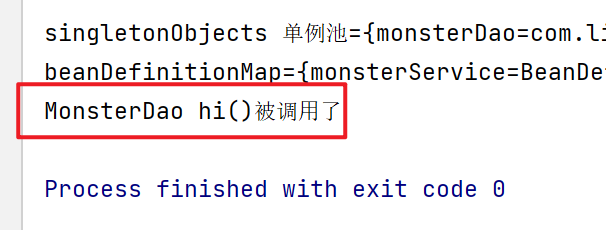
day12-实现Spring底层机制-02的更多相关文章
- Hibernate工作原理及为什么要用?. Struts工作机制?为什么要使用Struts? spring工作机制及为什么要用?
三大框架是用来开发web应用程序中使用的.Struts:基于MVC的充当了其中的试图层和控制器Hibernate:做持久化的,对JDBC轻量级的封装,使得我们能过面向对象的操作数据库Spring: 采 ...
- spring工作机制及为什么要用?
spring工作机制及为什么要用?1.spring mvc请所有的请求都提交给DispatcherServlet,它会委托应用系统的其他模块负责对请求进行真正的处理工作.2.DispatcherSer ...
- 如何妙用Spring 数据绑定机制?
前言 在剖析完 「Spring Boot 统一数据格式是怎么实现的? 」文章之后,一直觉得有必要说明一下 Spring's Data Binding Mechanism 「Spring 数据绑定机制」 ...
- 4-3 Spring MVC框架-02
Spring MVC框架-02 Ⅰ.RESTful基础 是一种设计风格和开发方式 1.get和post请求区别: get post 获取请求 上传请求 请求参数在地址栏URL 请求参数在请求体里面 U ...
- Spring 事务机制详解
原文出处: 陶邦仁 Spring事务机制主要包括声明式事务和编程式事务,此处侧重讲解声明式事务,编程式事务在实际开发中得不到广泛使用,仅供学习参考. Spring声明式事务让我们从复杂的事务处理中得到 ...
- spring工作机制
Hibernate.struts,还差一个spring 就一起发出去.. spring工作机制及为什么要用? 1.springmvc请所有的请求都提交给DispatcherServlet,它会委托应用 ...
- [转]STL 容器一些底层机制
1.vector 容器 vector 的数据安排以及操作方式,与 array 非常相似.两者的唯一区别在于空间的运用的灵活性.array 是静态空间,一旦配置了就不能改变,vector 是动态数组.在 ...
- Spring 事务机制详解(事务的隔离性和传播性)
原文出处: 陶邦仁 Spring事务机制主要包括声明式事务和编程式事务,此处侧重讲解声明式事务,编程式事务在实际开发中得不到广泛使用,仅供学习参考. Spring声明式事务让我们从复杂的事务处理中得到 ...
- Spring事件机制详解
一.前言 说来惭愧,对应Spring事件机制之前只知道实现 ApplicationListener 接口,就可以基于Spring自带的事件做一些事情(如ContextRefreshedEvent),但 ...
- C++ STL容器底层机制
1.vector容器 vector的数据安排以及操作方式,与array非常相似.两者的唯一区别在于空间的运用的灵活性.array是静态空间,一旦配置了就不能改变.vector是动态空间,随着元素的加入 ...
随机推荐
- 时序数据库TDengine 详细安装+集成流程+问题解决
官方文档:https://docs.taosdata.com/get-started/package/ 点击进入 产品简介 TDengine 是一款高性能.分布式.支持 SQL 的时序数据库 (Dat ...
- Linux环境下执行脚本重启Weblogic控制台中部署的应用程序
之前有写过一篇博文介绍切换登录方式的脚本,脚本中存在一个缺点:仍需手动去Weblogic控制台重启应用程序:本文即介绍如何在脚本中更新Weblogic控制台中部署的应用程序. 一.配置Weblogic ...
- docker清空网络配置
docker 网络 故障 相同的 ip 绑定给了 两个 网卡, 需要 清空 网络 ip addr | grep 10.79 inet 10.79.106.1/24 brd 10.79.106.255 ...
- Revit2021保姆级安装教程
Revit2021 WIN10 64位安装步骤: 1.先使用"百度网盘客户端"下载Revit_2021软件安装包到电脑磁盘里,并解压缩,安装全程需连接网络,然后双击打开Revit_ ...
- mysql 基础明细
1.mysql 没有 TOP,用limit实现 2.mysql having 聚合之后,对组操作,和GROUP By搭配 mysql where 聚合之前,对表和视图操作 3.where 子句的作用 ...
- Spring Cloud Circuit Breaker 使用示例
Spring Cloud Circuit Breaker 使用示例 作者: Grey 原文地址: 博客园:Spring Cloud Circuit Breaker 使用示例 CSDN:Spring C ...
- 【DL论文精读笔记】ResNet
Abstract 利用残差学习架构释放深度 152层深度是VGG的8倍,且复杂度更低 ImageNet上的错误率3.57% 在ILSVRC和2015COCO竞赛,在多项任务拿到第一 3.1 Intro ...
- webapi+vue跨域session丢失解决方法
前后端分离中在webapi设置可以跨域,在web.config文件中添加 <httpProtocol> <customHeaders> <ad ...
- 研究光度立体法阶段性小结和优化(可20ms获取4个2500*2000灰度图的Normal Map)。
这个东西是我接触的第一个非2D方面的算法,到目前为止其实也没有完全搞定,不过可能短时间内也无法突破.先把能搞定的搞定吧. 这个东西也有一大堆参考资料,不过呢,搜来搜去其实也就那些同样的东西,个人觉得就 ...
- X活手环的表盘自定义修改
文章用到的所有工具及软件成品 前言 前几天我在某宝买了一个智能手环,无奈软件中的表盘太少,所有我想着修改一下app中的资源文件. 反编译APK 这里反编译APK用apktool工具就可以. apkto ...
